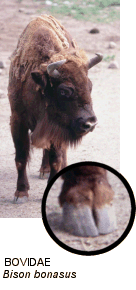 |
The Bovidae are the most diverse group of living ungulates with 143 Recent
species (over 55% of modern ungulates). Bovids are primarily Old World in
their distribution, although a few species are found in North America. The
name "antelope" is often used to describe many members of this family, but
it is not a definable, taxonomically-based term - if it's not an ox, goat,
or sheep, then it's an antelope; antelope are found in all eight modern
bovid subfamilies alongside distinctly non-antilopine species.
The present classification scheme for bovids recognizes eight subfamilies subdivided into two clades, the Boodontia (with a single subfamily, Bovinae) and Aegodontia (composed of all other bovid subfamilies). Some authors do not recognize these two clades, instead reducing the number of subfamilies to two: Bovinae (without change) and Antilopinae (with all of the Aegodontid subfamilies as tribes within it). Among the eight subfamilies presented here, the phylogeny of some groups is well-established (e.g., the Bovinae are monophyletic and basal; the Caprinae, Hippotraginae, and Alcelaphinae cluster together consistently), while the interrelationships of the other subfamilies are still under question. The family Bovidae began its evolution in Africa around 19 million years ago, and rapidly diversified, with 78 genera known from the Miocene (compared to 50 today). Kingdon (1997) suggests that a continental divide between Africa and Eurasia may be responsible for the early divergence of the Boodontia (Eurasian in origin) and the Aegodontia (which continued evolving in Africa). The rejoining of the two continental land masses (after these two principal clades had become distinct) at the Arabian peninsula removed this geographic barrier, allowing both groups to expand into the other's homeland. Today, Africa remains the heart of bovid diversity (representatives of all eight modern families inhabit the continent, and four of these families are found nowhere else). Three bovid subfamilies (Bovinae, Caprinae, and Antilopinae) are well-represented in Eurasia (while a fourth subfamily, the African Hippotraginae, has a single representative on the Arabian peninsula). The Americas, in comparison, have very few bovids (only five bovid species are native to the Nearctic region, and no bovids are found in the Neotropics). The bovid invasion of North America is relatively recent: the Bering Land Bridge connected Russia and Alaska during the Pleistocene and its northern climate prevented all but the most cold-tolerant species from crossing to North America. One of the defining characteristics of this family is the presence of unbranched horns. Horns are present in males of all bovid species and in females of some genera (most frequently in large species where adult females weigh over 40 kg). When horns are present in both sexes, those of males are always thicker at the base and more complex. The horns are permanently attached to the frontal bones of the skull, and are composed of a bone core covered with a keratin sheath (which is never shed). An air space separates these two layers, with the result that bovids are often called "hollow-horned ungulates". Tetracerus is unique among wild bovids in that males regularly bear four horns (two pairs); all other genera (with the exception of some domestic sheep) have only one pair. Bovids have the typical dentition of the ruminants - I 0/3, C 0/1, P 3/3, M 3/3 x 2 = 32. The upper canines are always absent. A single lacrimal canal is usually present in the orbits of the skull. |
(From Hernandez-Fernandez and Vrba, 2005)
| Bovinae |
or jump to the Bovidae Species List